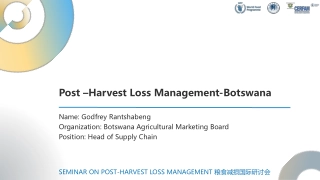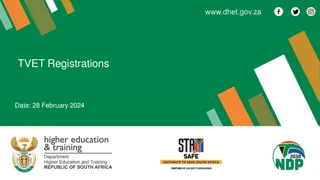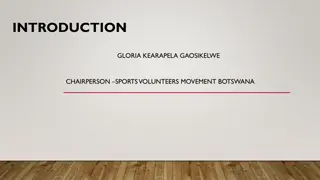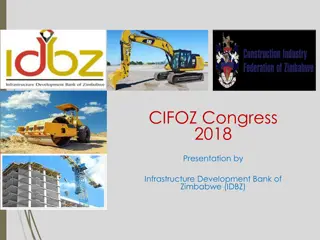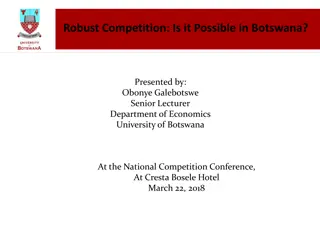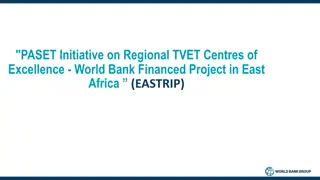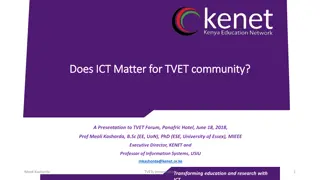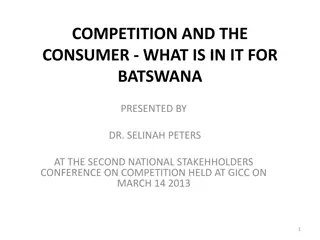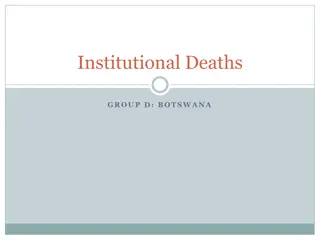Comparing TVET Funding Models in Botswana, South Africa & Zimbabwe
Sustainable TVET funding is crucial for quality vocational education. This study examines financing models in Botswana, South Africa, and Zimbabwe, focusing on public funding, company levy systems, and other mechanisms. The analysis explores challenges, incentives, monitoring policies, and recommendations for effective TVET funding. The Training Levy System in these countries is outlined, detailing the collection process and rates based on different wage brackets.
Download Presentation

Please find below an Image/Link to download the presentation.
The content on the website is provided AS IS for your information and personal use only. It may not be sold, licensed, or shared on other websites without obtaining consent from the author.If you encounter any issues during the download, it is possible that the publisher has removed the file from their server.
You are allowed to download the files provided on this website for personal or commercial use, subject to the condition that they are used lawfully. All files are the property of their respective owners.
The content on the website is provided AS IS for your information and personal use only. It may not be sold, licensed, or shared on other websites without obtaining consent from the author.
E N D
Presentation Transcript
THEME 2: TVET FUNDINDING MODELS Comparing Financing Models for Vocational Education and Training in Botswana, South Africa, and Zimbabwe Presented by JERALD HONDONGA From New Era college Gaborone , Botswana
Introduction Monitoring and Evaluation of Training Levy System Policies that guide TVET funding Incentives to ensure that industry supports Challenges in TVET Funding Conclusions Recommendations
INTRODUCTION INTRODUCTION Sustainable TVET funding models are important for an effective, efficient, competitive, flexible and a market demand-driven training system (Sheppard & Ntenga, 2015). Has an effect on the quality of graduates (UNESCO, 2015:5). Adequate funding ensures TVET instruction is not compromised by lack of adequate resources (Chakamba, Jumo, Edziwa, Chiweshe; 2013:117). High costs of TVET funding are for: Attracting and retaining highly skilled and qualified teaching personnel Training infrastructure (classrooms, specialised workshops Equipment Training materials/consumables associated with low student numbers per class. TVET systems must be adequately and sustainably funded to transform with technological and labour market changes to remain relevant.
Funding for TVET in Botswana, South Africa, and Zimbabwe is predominantly through public funding and company levy system (UNESCO, 2012:10). Other funding mechanisms: Income generating activities Sectoral funding Self-sponsorship (Hondonga & Ramaligela, 2019). Grant-loan scheme/Cost sharing Bank -Trainee loans. Corporate and donor funding Most fiscal budget allocations fall far below international spending threshold of 20% set by the Dakar Framework for Education, as well as the 22% SADCC benchmark. In SA, R14.385 billion with a correlating budget deficit of R165 million or 1.15% funding deficit for 2022 enrolments.
Training Levy System in the 3 countries Botswana South Africa Zimbabwe The Training Levy is collected by Botswana Unified Revenue Service (BURS) based on the Value Added Tax threshold and HRDC manages the Fund Established in April 2014 The funds are paid to the South African Revenue Services (SARS) and are to be used to develop and improve skills of employees in the workplace. Established in 199 Collected Authority(ZIMRA) In terms of section 53 of the Manpower Planning & Development Act (Chapter 28:02) and Statutory Instruments 74 & 392of 1999. Established in 1984 through Zimbabwe Revenue The payment is based on 1% of the total wage bill for all companies Training Levy is collected at the following rates Earning Less than P1,000,000.00 - P1,000,000.00 to 2 billion - Excess of 2 billion - Companies pay 1% of the total amount paid in salaries to employees No Levy 0.2% 0.05% Includes all companies that pay over R500 000 a year in salaries and wages to employees (even if they re not registered for PAYE with SARS).
Monitoring Monitoring and Evaluation of Training Levy System and Evaluation of Training Levy System There are funding policies in the three countries which to guides collection of levies and other funding resources, and their utilisation. Policies help to show transparency and create a platforms of accountability to administrators and those who are meant to benefit from the funds. Policies are there as basis for reviewing TVET funding needs for the country. for the country. There are funding policies in the three countries which to guides collection of levies and other funding resources, and their utilisation. Policies help to show transparency and create a platforms of accountability to administrators and those who are meant to benefit from the funds. Policies are there as basis for reviewing TVET funding needs
Policies Policies in Botswana in Botswana The Revised national policy on Education (RNPE,(1994), National Policy on Vocational Education and Training (NPVET, 1997) and the Vocational Training Act (VTA, 1998). The Human Resources Development Act of 2013 Human Resources Development Fund 2014 Birth of Human Resources Development Levy The Botswana Qualification Authority (BQA) guidelines for registration and accreditation conventional training requires policies to be in place indicating how financial resources are managed to avoid misuse
Policies in South Africa Policies in South Africa National Norms and Standards for Funding Technical and Vocational Education and Training which was published in terms of the CET Act, No 16 of 2006 for effective implementation in 2010. National Skills Fund (established to support priority skills and innovative research in high-level occupationally universities to the workplace.) The Professional, Vocational, Technical (PIVOTAL) grant (focuses on placements, work integrated learning, apprenticeships, learnerships, internships, skills programs and work experience placements). and Sector Education and Training Authority (SETA, 2015) -distributes discretionary funds for purposes of upgrading skills in the workforce. directed programmes from and access Academic to Learning professional providing
Policies in Zimbabwe Policies in Zimbabwe Apprenticeship Training and Skilled Manpower Development Act (1968) established to sustain the common effort of industry to produce skilled workers required by industry in general. Manpower Planning and Development Act (1984) - to create a pool of training funds in general. The funds are pulled together through a levy fixed at 1% annual wage bills for employers (Munetsi, 1996). Companies are given incentives in the form of tax rebates and grants if they are involved in approved training. The fund continues to get interests from the Fund s short-term investment and rentals from leased properties.
Incentives to Encourage Industry Support Incentives to Encourage Industry Support To encourage companies to pay levies, the different countries introduced some rebates as incentives for companies to continue paying levies and get involved in skills development activities. For example, Botswana South Africa Zimbabwe Companies reimbursement costs Training Levy Fund for costs incurred on training of their own employees. Claimable costs tuition, stationery, salaries prorated to number of days in training and travel costs. can claim of the for For the Skills Development Levy (SDL), Employers mandatory grant equal to 20% of the levies they paid if they submit a Workplace Skills Plan (WSP) and an Annual Training Report (ATR). ZIMDEF pays rebates to employers who participate in human capital programmes. Some the claimable costs include: Claims for apprenticeship training Upgrade of employees approved industrial training centres On-the job training of company s on employees to acquire membership of professional bodies Provision of trade testing facilities Release of employees for part-time lecturing and technical colleges training HRDC are paid a from through include trainee
Implications of COVID Implications of COVID- -19 towards levy contribution 19 towards levy contribution Naturally there was and still reduced company profits and some companies liquidating which in turn reduced the total amount of levy remittances, for example, SA-revenue dropped from our projection of R19.4 billion to R12.4 billion, as a result of the skills levy holiday for employers who contribute the 1% skills development levy. Botswana-Waiver of payment of the Vocational Training Levy for six months Zimbabwe- small-to-medium enterprises are not registered, do not pay taxes (Zimbabwe National Statistics Agency [ZimStats], 2021) . There is no transparency on revenue collected in Zimbabwe.
Implications of COVID Implications of COVID- -19 towards levy 19 towards levy contributions contributions Naturally Training Levy contributions reduced as company profits and some companies liquidating, and due to Tax holidays introduced. In Zimbabwe, companies operating in the small-to-medium scale enterprise sector are not registered, and it is difficult to monitor their compliance with statutory obligations of paying taxes (Zimbabwe National Statistics Agency [ZimStats], 2021) . Corporate tax remains Zimbabwe s largest revenue head, which contributed 25,24% in 2021 but there is no transparency on revenue collected.
Challenges in TVET Funding Challenges in TVET Funding Inadequate funding for TVET to meet all funding needs of training resources, student tuition and allowances leading to further social economic challenges of: Wastage in education(No value for money invested) Irrelevant graduate skills (for local and international labour market) Graduate/learner skills mismatch Rising graduate unemployment, and has ripple effects even to the socio- economic status of citizens (UNESCO, 2012). Poor management of revolving funds.
Challenges continued--- Non-repayment of loans due to inefficient recovery system from graduating students. High demand for students sponsorship from government (in the three countries) as parents cannot afford Poor image of the TVET sub-sector thereby failing to attract sponsors especially in skills training centres- last resort for students who fail to enrol for Higher education Inequitable and insufficient funding, especially in historically disadvantaged colleges.- a case in SA Additional cost to acquire methodologies and support online teaching
Conclusions Conclusions There are a number funding models in the three countries Predominantly public funding, levy-grant system. Other sources of funding include corporate and donor funding, income generating activities at institutional level, fees from students through self-sponsorship, students bursaries, and student grant-loan schemes.
Recommendations To expand company benefits for taking part in Human Resources Development(see the wider company benefits in Zimbabwe) Recommend paying scarce skills/retention allowances to attract and retain competent and qualified TVET teachers Countries are finding it unsustainable to fully depend on public budget funding Sectoral funding is sustainable as it considers those jobs skills demand on the labour market. Labour market surveys are important and must be considered for sectoral funding allocations to avoid wastage of funding resources in
SAMPLE TEXT Land begotten by our forefathers, land as big as the palm of my hand yet containing greater things that great nations hold not, It s a land full of life ,beauty that surpasses all
3933533 www.neweracollege.ac.bw


